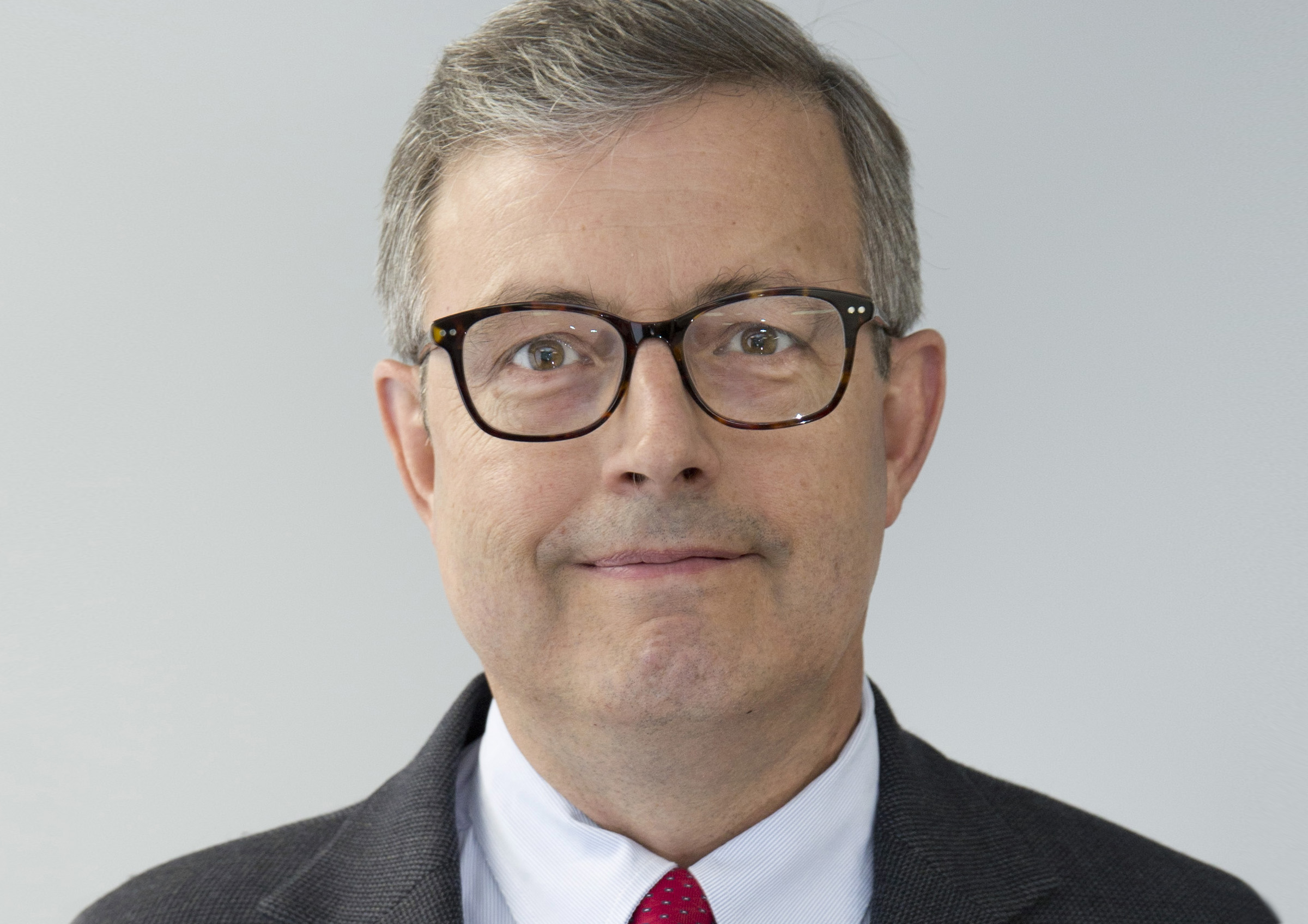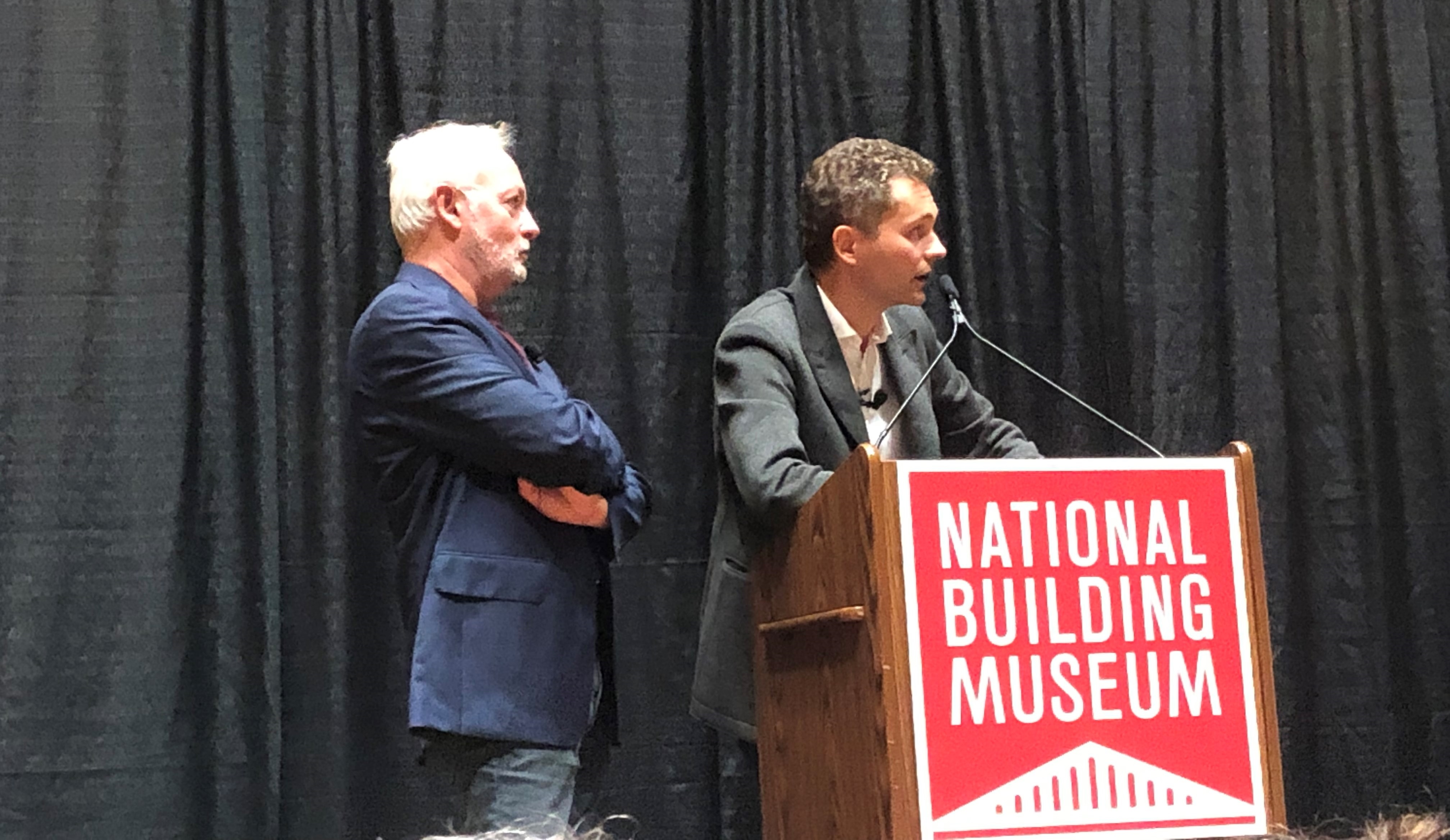Nearly three and one-half years after a calamitous fire engulfed the roof and collapsed the spire of Notre-Dame Cathedral in Paris, two of the French architects directing the restoration efforts there visited Washington, D.C., and spoke at the National Building Museum about the project’s progress.
The Sept. 26 lecture by Philippe Villeneuve, the chief architect of historic monuments in charge of Notre-Dame de Paris Cathedral, and his colleague Rémi Fromont, also a chief architect of historic monuments there, was delivered in French and translated live into English by Lindsay Cook, assistant teaching professor of architectural history in the Department of Art History at The Pennsylvania State University. Their lecture was titled “Notre-Dame de Paris: Restoring a Legacy.”
A February 2022 cover story in National Geographic magazine noted that Villeneuve has led restoration efforts at Notre-Dame Cathedral since 2013, work that became urgent after the April 2019 fire.
The architect called the cathedral “a monument of humanity,” and he thanked those in the museum audience, saying, “It is amazing to see, 6,000 kilometers away from Paris, the same spirit that we ourselves have for Notre-Dame ourselves.”
Villeneuve noted that before the fire, Fromont and a colleague had made the most complete hand-drawn survey of the roof, a study that has proven invaluable in reconstructing the cathedral’s wooden roof framework. “He is responsible for the roof,” he said of his colleague who also spoke that evening.
He explained that a third French architect, Pascal Prunet, has connected the cathedral with universities and groups focusing on its components, its structure and its history, studying its burned remains to better understand the cathedral as the restoration work unfolds.
Noting the progress of the restoration of Notre-Dame Cathedral, Villeneuve said, “We are confident that the deadline of five years, introduced by the French president, is still possible.”
France's President Emmanuel Macron had set a goal for the cathedral to be restored by 2024, the year when Paris will be hosting the Summer Olympics.
The two French architects came to Washington on a day when a full-sized replica of the cathedral’s truss was raised on the campus of The Catholic University of America. That 45-foot-wide by 35-foot-high replica truss had been hand-hewn and built on campus in 2021 by faculty and students from Catholic University’s School of Architecture and Planning and by volunteers from the education non-profit Handshouse Studio. They replicated the traditional building methods used when the cathedral was built in the Middle Ages, 800 years earlier, based on blueprints provided by Notre-Dame architects.
As they had done a year earlier, the CUA students, faculty, Handshouse Studio representatives and other volunteers raised the replica truss on the University Mall next to the Basilica of the National Shrine of the Immaculate Conception.
Catholic University also hosted a panel discussion about the cathedral’s restoration and an exhibit in its Crough Center for Architectural Studies that included student-designed replicas of Notre-Dame Cathedral and its elements, including its famous flying buttresses.


The French architects’ lecture that evening was hosted by the National Building Museum, which since April 15 has featured “Notre-Dame de Paris: The Augmented Exhibition.” Through interactive technology, the exhibit provides an augmented reality immersion into the 850-year history of the cathedral and its ongoing restoration. That exhibit ran through Oct. 9.
Aileen Fuchs, the president and executive director of the National Building Museum, noted the museum’s long partnership with the architecture school at Catholic University. Introducing the speakers, she said it marked the first time that two of the cathedral’s chief architects had come to the United States to speak about “their groundbreaking work to rebuild this global treasure after the disastrous 2019 fire.”
Mark Ferguson, the dean of Catholic University’s School of Architecture and Planning, also spoke, noting, “To restore a building is to immerse yourself in the mind of the maker.” He said the replica truss raised at the university “symbolizes the love the international community has for the building and all it represents.”
Before the lecture at the museum, many guests toured its interactive exhibit, which traced the history of the construction of Notre-Dame Cathedral, highlighted events there in the centuries that followed, and detailed its restoration after the 2019 fire. From the laying of its foundation stone in 1163, the building of the cathedral took nearly two centuries.
With touch-screen tablets, the exhibit’s viewers could see animated scenes of the blacksmiths, woodcutters, quarrymen, carpenters and stonemasons building the cathedral as it rose to a height of 35 meters (almost 115 feet), a record for the 12th century. Its wooden roof, constructed from more than 1,000 massive oak trees, was nicknamed “The Forest.” The masterpiece of medieval architecture was one of the first buildings to incorporate flying buttresses.
The exhibit highlighted an earlier restoration effort at Notre-Dame Cathedral led by architect Eugéne-Emmanuel Viollet-le-Duc, who instead of restoring the spire from 1250 had an ornate, two-story wooden Gothic spire erected on its roof between 1857-59 that became an iconic part of the skyline of Paris.
The exhibit also included dramatic footage of the flames roaring from the cathedral’s roof, as members of the Paris Fire Brigade, who had arrived within nine minutes of being alerted, heroically battled and ultimately extinguished the fire, but the fire gutted and destroyed the wooden roof and caused the majestic spire to collapse.
As viewers walked through the exhibit, they could also see interactive scenes of more heroism, as a new generation of craftspeople, including roofers, painting and sculpture restorers, master glassmakers and carpenters and stonemasons, are working to restore Notre-Dame Cathedral to its past glory.


Philippe Villeneuve, the first of the French architects to speak at the lecture, pointed out some seeming miracles in the aftermath of the fire, like the famous statue of the Virgin Mary of Notre-Dame Cathedral emerging largely unscathed, not far from piles of rubble from the collapsed roof.
He noted that “not a single piece of stained glass was damaged during the fire,” but the windows were removed for cleaning. The cathedral’s famous sculptures of chimeras (gargoyles) also were not damaged. And in a twist of fate, days before the fire, large statues of the 12 apostles had been removed from the base of the spire for restoration, so they weren’t damaged in the conflagration.
The cathedral’s most famous relics – including the reported crown of thorns worn by Jesus at his crucifixion, and the tunic of King Louis IX, St. Louis –were carried out of the cathedral during the fire and saved.
“The furnishings were also rescued,” Villeneuve said, adding, “The organ, in particular, was saved, thankfully. That said, there was dust and ash from the fire, as well as lead dust, which has needed to be cleaned.”
The French architect described measures taken to stabilize the cathedral, including shoring up the flying buttresses with wooden centering to avoid structural collapse.
Rémi Fromont, the second French architect to speak at the museum lecture, described how he and a colleague, Cédric Trentesaux, had made the detailed study of the cathedral’s roof before the fire. “These drawings were made entirely by hand. Our goal was to draw everything we saw,” he said. Then after the fire, their restoration work was guided by those drawings and by other documentation on the roof, including by the carpentry firm that constructed the 19th century spire and made a small model of it.
Fromont said the plan for the restoration of the roof and the spire is to restore them just as they were before the fire.
“What were our options?” he asked. “We could have left nothing, left a void, to remember the fire. However, since Notre-Dame is a UNESCO World Heritage Site, this option wasn’t feasible, as the heritage listing includes the silhouette of Notre-Dame, which relies heavily on the shape of the roof. Another option was to restore the roof in a contemporary way. It would’ve been possible technically, but ultimately we decided that the version of the cathedral Viollet-le-Duc envisioned was Gothic… It became important for us ultimately, then, to restore the cathedral in its entirety.”
He noted that the restoration work “will largely be done by hand… the way the craftspeople working on the site work best is by working the way artisans did in the 13th century, which is by hand.”
And Fromont said they scoured oak forests throughout France “for the best oaks to restore the roof framework and spire… They are incredibly tall, straight and frankly perfect.” New trees will be planted to grow in their place, continuing the life cycle of forests, he said.
In his closing remarks, Villeneuve said a copper rooster sculpture that had been on top of the cathedral’s spire was found after the fire heavily damaged on the street below, and it will be replaced on the new spire by a redesigned rooster sculpture. “I think of it as a kind of phoenix,” he said of the artwork that perhaps symbolizes the ultimate rebirth of the restored Notre-Dame Cathedral of Paris.








